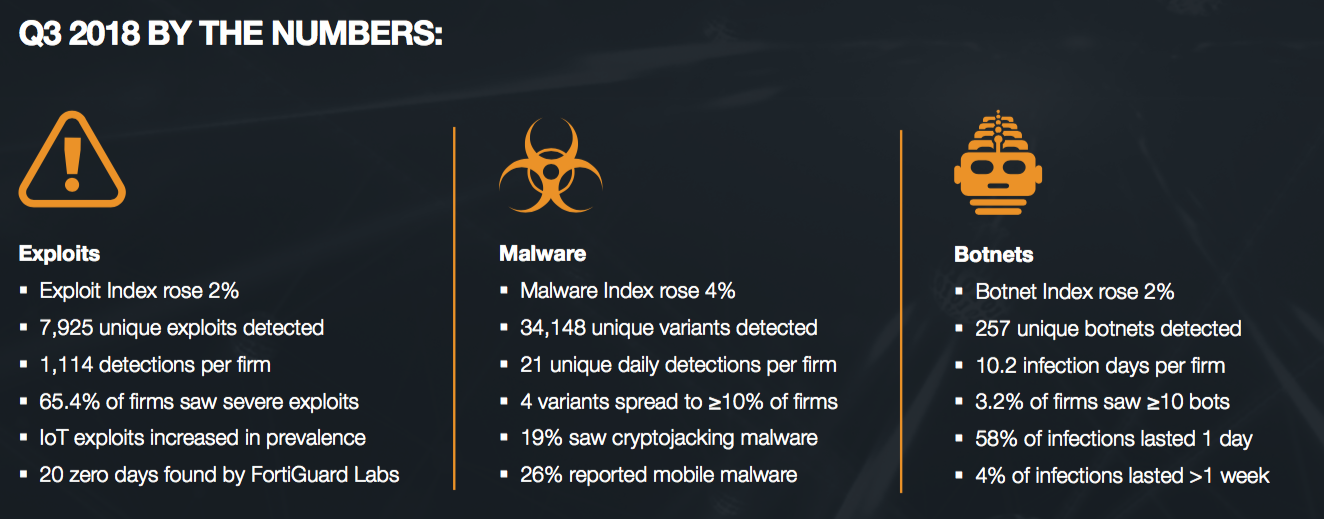“Cyberthreats are growing rapidly and every organization is feeling the impact, with daily detections and exploits increasing. Previously, ransomware was the talk of the day, and now cryptojacking, mobile malware, and attacks against business-critical supply chains are proliferating. As our cyber adversaries continue to incorporate new threats and leverage increasingly automated techniques at speed and scale for their malicious activities, segmentation and integration, have become critical security strategies for IT and OT environments today.”, said Phil Quade, Chief Information Security Officer, Fortinet

Fortinet® (NASDAQ: FTNT), a global leader in broad, integrated, and automated cybersecurity solutions, today announced the findings of its latest quarterly Global Threat Landscape Report. The research reveals threats are increasing and evolving to become more sophisticated. Unique threat variants and families are on the rise, while botnet infections continue to infect organizations. For a detailed view of the Threat Landscape Indices for exploits, botnets, and malware as well as some important takeaways for CISOs read the blog. Highlights of the report follow:
Threat Development Continues to Be a Top Focus for Cybercriminals. Cybercriminals are not only expanding their attack arsenal but also developing new strategies for breaching defenses. Unique malware variants grew 43%, while the number of malware families grew by nearly 32% for the same period. The number of unique daily malware detections per firm also rose 62%. In line with these trends, unique exploits increased nearly 10% and the number of exploit detections per firm rose 37%. Cybercriminals continue to evolve threats by creating unique malware variants and families, demonstrating the ongoing importance of threat intelligence and assessment tools.
Mobile Devices Remain a Target. Over one-quarter of organizations experienced a mobile malware attack, with the majority being on the Android operating system. In fact, of the threats organizations faced from all attack vectors, 14% of total malware alerts were Android related. By comparison, only .000311% of threats were targeted to Apple iOS. Mobile threats are a looming threat that must be addressed, especially as the mobile-shopping holiday season nears. These threats can become a gateway for corporate networks to be exploited. Criminals know mobile is an accessible target for infiltrating a network, and they are exploiting it.
Cryptojacking is a Gateway to Other Attacks. Cryptojacking remains prevalent and continues to grow in scope. The number of platforms affected by cryptojacking jumped 38% and the number of unique signatures nearly doubled in the past year. These include new sophisticated platforms for advanced attackers as well as “as-a-service” platforms for novice criminals. IoT botnets are also increasingly leveraging cryptojacking exploits for their attack strategy. Although it is often considered to be a nuisance threat that simply hijacks unused CPU cycles, security leaders are realizing how cryptojacking can become a gateway for additional attacks. Underestimating the repercussions of cryptojacking places an organization under heightened risk.
Percentage of Malicious Network Traffic is Higher on Weekends or Holidays. Data shows malicious network traffic represents a higher percentage of overall traffic on weekends and holidays as business traffic slows down significantly. The reason for this is that many employees aren’t working during this time at most organizations and the amount of business traffic is often lower. As the “haystack” of traffic becomes smaller, the chance of finding malicious “needles” is much greater. With cybercriminals using more automated and sophisticated techniques, any opportunity to increase visibility can be an advantage.
Burstiness of Botnets. The botnet index rose only 2%, though the number of infection days per firm increased 34% from 7.6 days to 10.2 days. This may be an indication that botnets are becoming more sophisticated, difficult to detect, or harder to remove. It may also denote a failure to practice good cyber hygiene in general by some organizations. The importance of security hygiene remains vital to thoroughly understand the total scope of these attacks. Sometimes botnets can go dormant, only to return after normal business operations have resumed, if the root cause or “patient zero” are not determined.
Encrypted Traffic Reaches a New Threshold. Encrypted traffic represented over 72% of all network traffic, up from 55% just one year ago. While encryption can certainly help protect data in motion as it moves between core, cloud, and endpoint environments, it also represents a challenge for traditional security solutions. Critical firewall and IPS performance limitations of some legacy security solutions continue to limit organizations from inspecting encrypted data. As a result, this traffic is increasingly not analyzed for malicious activity, making it an ideal mechanism for criminals to spread malware or exfiltrate data.

Digital Change Requires a New Approach to Security
The threat data in this quarter’s report once again reinforces many of the threat prediction trends unveiled by the FortiGuard Labs global research team. Organizations need to transform their security strategies as part of their digital transformation efforts. Isolated, legacy security devices and poor security hygiene continue to be a formula for increased risk to today’s threat landscape as they do not provide adequate visibility or control. Instead, a security fabric that spans the entire expanded network environment and is integrated between each security element is vital to address today’s growing threat environment and protecting the expanding attack surface. This approach enables actionable threat intelligence to be shared at speed and scale, shrinks the necessary windows of detection, and provides the automated remediation required for today’s multi-vector exploits.
Report and Index Overview
The Fortinet Threat Landscape Report is a quarterly view that represents the collective intelligence of FortiGuard Labs drawn from Fortinet’s vast array of sensors during Q3 2018. Research data covers global and regional perspectives. Also included in the report is the Fortinet Threat Landscape Index (TLI), comprised of individual indices for three central and
complementary aspects of that landscape which are exploits, malware, and botnets, showing prevalence and volume in a given quarter. The report also examines important zero-day vulnerabilities and infrastructure trends to add context about the trajectory of cyber attacks affecting organizations over time. To complement the report, Fortinet publishes a free, subscription-based Threat Intelligence Brief that reviews the top malware, virus, and web-based threats discovered every week, along with links to valuable FortiGuard Labs threat research.






